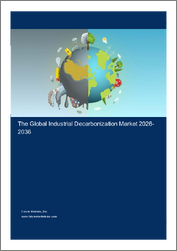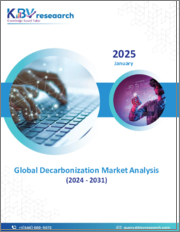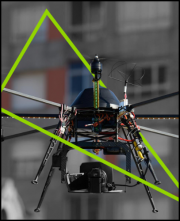
|
시장보고서
상품코드
1662862
세계의 탈탄소화 시장 예측(-2030년) : 서비스별, 재생 가능 에너지별, 기술별, 전개별, 최종 사용자별, 지역별 분석Decarbonization Market Forecasts to 2030 - Global Analysis By Service, Renewable Energy, Technology, Deployment, End User and By Geography |
||||||
Stratistics MRC에 따르면 세계의 탈탄소화 시장은 2024년에 3,553억 달러였고, CAGR 14.0%를 나타낼 전망이며, 2030년에는 7,799억 달러에 달할 것으로 예측되고 있습니다.
탈탄소화는 에너지, 수송, 산업 등 다양한 부문에서 배출되는 이산화탄소(CO2) 및 기타 온실가스를 줄이거나 제거하는 과정입니다. 여기에는 저탄소 또는 재생 가능 에너지원으로의 전환, 에너지 효율 개선, 보다 깨끗한 기술 채택이 포함됩니다. 탈탄소화의 목표는 인간 활동의 이산화탄소 배출량을 줄임으로써 기후 변화를 완화하는 것입니다. 이 전환은 파리 협정과 같은 세계의 기후 변화 목표를 달성하고 지구의 지속 가능하고 강인한 미래를 확보하는 데 필수적입니다.
기업의 지속가능성에 대한 노력 증가
기업이 환경에 미치는 영향을 줄일 필요성을 인식함에 따라 시장에서 기업의 지속가능성에 대한 노력이 확대되고 있습니다. 기업은 보다 깨끗한 기술을 채택하고, 재생 가능 에너지에 대한 투자, 에너지 효율 개선, 넷 제로 방출의 목표 설정을 진행하고 있습니다. 이러한 노력은 기후 변화를 완화하는 데 도움이 될 뿐만 아니라 브랜드의 명성을 높이고, 환경 의식이 높은 소비자를 유치하고, 규제 압력을 준수하는 데도 도움이 됩니다. 지속가능성에 대한 헌신 증가는 혁신을 촉진하고 시장에 새로운 기회를 창출하고 있습니다.
국민의 인식과 지지의 부족
시장에서 일반 시민의 인식과 지원의 부족은 신재생에너지 기술과 지속가능한 실천의 채용을 방해할 수 있습니다. 광범위한 이해가 없으면 사람들은 필요한 조치 변경이나 녹색 솔루션에 대한 투자에 저항하여 진보가 지연 될 수 있습니다. 이는 화석연료에 대한 의존을 계속하고, 기후 변화 대책을 늦추고, 정부 인센티브의 효과를 저하시키고, 궁극적으로 이산화탄소 감축 목표 달성과 기후 변화 완화 노력을 해칠 수 있습니다.
신재생에너지 기술의 발전
강화된 태양전지판, 해상 풍력 발전소, 첨단 에너지 저장 시스템 등 최근의 재생 가능 에너지 기술의 진보가 시장을 가속화하고 있습니다. 페로브스카이트 태양전지와 부유식 풍력 터빈과 같은 기술 혁신은 효율성과 확장성을 높입니다. 또한 수소 제조 및 탄소 회수 기술의 획기적인 발전은 배출량을 줄이는 데 기여하고 산업이 더 깨끗한 에너지원으로 전환 할 수 있게 합니다. 이러한 개발은 세계 기후 변화 목표를 달성하는 데 필수적입니다.
경제과제와 예산제약
경제적 과제와 예산의 제약은 신재생에너지 프로젝트, 기술 개발, 인프라 정비에 대한 투자를 제한함으로써 시장에 심각한 영향을 미칠 수 있습니다. 정부와 기업은 환경친화적인 노력에 대한 자금 조달을 고민하고 보다 깨끗한 에너지로의 전환을 지연시킬 수 있습니다. 게다가 재정적인 제약은 연구와 혁신의 감소로 이어져 지속가능한 해결책을 확대하고 기후 목표를 달성하기 어려워지며 궁극적으로 화석 연료에 대한 의존도를 늘리고 탈탄소화 노력을 늦추게 됩니다.
COVID-19의 영향
COVID-19의 대유행은 신재생에너지 프로젝트 지연, 공급망 혼란, 녹색기술 투자 감소로 이어져 시장을 혼란시켰습니다. 세계의 봉쇄에 의해 배출량은 일시적으로 감소한 것, 경제의 불확실성과 예산의 제약이 보다 깨끗한 에너지로의 이행을 지연시켰습니다. 그러나 한편으로는 재해에 강하고 지속가능한 에너지 시스템의 필요성이 부각되고, 각국 정부에 그린 부흥 계획의 검토를 촉구하고, 유통 후 장기적인 탈탄소화에 대한 대처를 가속시킬 가능성도 있습니다.
예측 기간 동안 태양에너지 부문이 최대 시장 점유율을 차지할 전망
예측 기간 동안 태양에너지 부문이 가장 큰 시장 점유율을 차지할 것으로 예상됩니다. 보다 효율적인 패널 및 에너지 저장 솔루션과 같은 태양광 발전 기술의 발전으로 비용이 낮아지고 확장성이 높아지고 있습니다. 그 결과, 태양광 발전은 세계적으로 급속히 채용되어, 이산화탄소 배출량의 삭감, 에너지의 자립, 지속 가능한 경제 성장에 공헌하고 있습니다. 태양광 발전은 기후 변화 목표를 달성하고 청정 에너지로의 전환을 촉진하는데 중요한 원동력이 되고 있습니다.
예측 기간 동안 에너지 및 유틸리티 부문의 CAGR이 가장 높아질 전망
예측 기간 동안 에너지 및 유틸리티 부문은 화석 연료에서 풍력, 태양광, 수력 등 재생 가능 에너지로의 이동을 추진하기 위해 가장 높은 성장률을 나타낼 것으로 예측됩니다. 유틸리티자는 보다 깨끗한 송전망, 에너지 저장, 스마트 기술에 투자하여 효율성을 높이고 배출량을 줄이고 있습니다. 이 변화는 세계 에너지 수요 증가에 대응하면서 지속가능하고 저탄소 에너지의 미래를 확보하기 위해 상당한 인프라 업그레이드, 시책 지원, 혁신이 필요합니다.
최대 점유율을 차지하는 지역
예측 기간 동안 북미가 가장 큰 시장 점유율을 차지할 것으로 예상됩니다. 미국과 캐나다는 신재생에너지원, 전기자동차, 탄소회수기술에 투자하고 있습니다. 주와 연방 정부의 인센티브가 청정 에너지 전환을 지원하고 기업의 지속가능성 목표가 시장 도입을 가속화하고 있습니다. 그러나 인프라 업그레이드, 정치적 차이, 경제적 압력 등의 과제는 이 지역의 탈탄소화 노력에 남아 있습니다.
CAGR이 가장 높은 지역
예측 기간 동안 아시아태평양이 가장 높은 CAGR을 나타낼 것으로 예상됩니다. 중국, 인도, 일본, 호주 등 국가들은 태양광, 풍력, 수력 등 신재생에너지에 많은 투자를 하고 있습니다. 이 나라들은 더 깨끗한 에너지를 찾고 화석 연료로부터의 전환을 목표로합니다. 게다가 아시아태평양에서는 그린본드와 지속가능한 투자가 중시됩니다. 투자자들은 저탄소 프로젝트에 투자 기회를 요구하고 있으며, 각국 정부는 녹색 프로젝트에 인센티브를 제공합니다.
무료 맞춤형 서비스
이 보고서를 구독하는 고객은 다음 무료 맞춤설정 옵션 중 하나를 사용할 수 있습니다.
- 기업 프로파일
- 추가 시장 진출기업의 종합적 프로파일링(3개사까지)
- 주요 기업의 SWOT 분석(3개사까지)
- 지역 세분화
- 고객의 관심에 응한 주요국 시장 추정·예측·CAGR(주: 타당성 확인에 따름)
- 경쟁 벤치마킹
- 제품 포트폴리오, 지리적 존재, 전략적 제휴를 통한 주요 기업 벤치마킹
목차
제1장 주요 요약
제2장 서문
- 개요
- 이해관계자
- 조사 범위
- 조사 방법
- 데이터 마이닝
- 데이터 분석
- 데이터 검증
- 조사 접근
- 조사 정보원
- 1차 조사 정보원
- 2차 조사 정보원
- 전제조건
제3장 시장 동향 분석
- 소개
- 성장 촉진요인
- 억제요인
- 기회
- 위협
- 기술 분석
- 최종 사용자 분석
- 신흥 시장
- COVID-19의 영향
제4장 Porter's Five Forces 분석
- 공급기업의 협상력
- 구매자의 협상력
- 대체품의 위협
- 신규 참가업체의 위협
- 경쟁 기업간 경쟁 관계
제5장 세계의 탈탄소화 시장 : 서비스별
- 소개
- 탄소 회계 및 보고 서비스
- 폐기물 삭감과 순환형 경제 서비스
- 지속 가능한 운송 서비스
제6장 세계의 탈탄소화 시장 : 재생 가능 에너지별
- 소개
- 태양에너지
- 풍력에너지
- 수력 발전
- 지열 에너지
- 바이오매스와 바이오에너지
제7장 세계의 탈탄소화 시장 : 기술별
- 소개
- 신재생에너지 기술
- 탄소 회수 및 저류(CCS)
- 에너지 효율 솔루션
- 탄소 제거 기술
- 전기자동차(EV)
제8장 세계의 탈탄소화 시장 : 전개별
- 소개
- 온프레미스
- 클라우드
제9장 세계의 탈탄소화 시장 : 최종 사용자별
- 소개
- 석유 및 가스
- 제조업
- 에너지 및 유틸리티
- 항공우주 및 방위
- 농업
- 자동차 및 운송
- 정부
- 기타
제10장 세계의 탈탄소화 시장 : 지역별
- 소개
- 북미
- 미국
- 캐나다
- 멕시코
- 유럽
- 독일
- 영국
- 이탈리아
- 프랑스
- 스페인
- 기타 유럽
- 아시아태평양
- 일본
- 중국
- 인도
- 호주
- 뉴질랜드
- 한국
- 기타 아시아태평양
- 남미
- 아르헨티나
- 브라질
- 칠레
- 기타 남미
- 중동 및 아프리카
- 사우디아라비아
- 아랍에미리트(UAE)
- 카타르
- 남아프리카
- 기타 중동 및 아프리카
제11장 주요 개발
- 계약/파트너십/협업/합작투자(JV)
- 인수와 합병
- 신제품 발매
- 사업 확대
- 기타 주요 전략
제12장 기업 프로파일링
- Tesla
- Orsted
- NextEra Energy
- Enel Green Power
- Siemens
- Schneider Electric
- Mitsubishi Heavy Industries
- Deloitte
- Brookfield Renewable Partners
- General Electric
- Dominion Energy
- BP
- Shell
- LanzaTech
- TotalEnergies
- Microsoft
According to Stratistics MRC, the Global Decarbonization Market is accounted for $355.3 billion in 2024 and is expected to reach $779.9 billion by 2030 growing at a CAGR of 14.0% during the forecast period. Decarbonization is the process of reducing or eliminating carbon dioxide (CO2) and other greenhouse gas emissions from various sectors, particularly energy, transportation, and industry. It involves transitioning to low-carbon or renewable energy sources, improving energy efficiency, and adopting cleaner technologies. The goal of decarbonization is to mitigate climate change by decreasing the carbon footprint of human activities. This shift is essential for achieving global climate targets, such as those outlined in the Paris Agreement, and for ensuring a sustainable and resilient future for the planet.
Market Dynamics:
Driver:
Increasing corporate sustainability initiatives
Corporate sustainability initiatives in the market are growing as businesses recognize the need to reduce their environmental impact. Companies are adopting cleaner technologies, investing in renewable energy, improving energy efficiency, and setting net-zero emissions targets. These efforts not only help mitigate climate change but also enhance brand reputation, attract environmentally-conscious consumers, and comply with regulatory pressures. Increased commitment to sustainability is driving innovation and creating new opportunities in the market.
Restraint:
Lack of public awareness and support
A lack of public awareness and support in the market can hinder the adoption of renewable energy technologies and sustainable practices. Without broad understanding, people may resist necessary policy changes or investments in green solutions, slowing down progress. This can lead to continued reliance on fossil fuels, delay climate action, and reduce the effectiveness of government incentives, ultimately undermining efforts to meet carbon reduction targets and mitigate climate change.
Opportunity:
Advancements in renewable energy technologies
Recent advancements in renewable energy technologies, such as enhanced solar panels, offshore wind farms, and advanced energy storage systems, are accelerating the market. Innovations like perovskite solar cells and floating wind turbines increase efficiency and scalability. Additionally, breakthroughs in hydrogen production and carbon capture technologies contribute to reducing emissions, enabling industries to transition to cleaner energy sources. These developments are crucial for achieving global climate targets.
Threat:
Economic challenges and budget constraints
Economic challenges and budget constraints can severely impact the market by limiting investment in renewable energy projects, technology development, and infrastructure upgrades. Governments and businesses may struggle to fund green initiatives, slowing the transition to cleaner energy. Additionally, financial limitations can lead to reduced research and innovation, making it harder to scale up sustainable solutions and reach climate goals, ultimately prolonging dependence on fossil fuels and delaying decarbonization efforts.
Covid-19 Impact:
The COVID-19 pandemic disrupted the market by causing delays in renewable energy projects, supply chain disruptions, and reduced investments in green technologies. While emissions temporarily dropped due to global lockdowns, economic uncertainty and budget constraints slowed the transition to cleaner energy. However, it also highlighted the need for resilient, sustainable energy systems, prompting governments to consider green recovery plans, potentially accelerating long-term decarbonization efforts post-pandemic.
The solar energy segment is expected to be the largest market share during the forecast period
The solar energy segment is expected to account for the largest market share during the forecast period. Advances in solar technology, such as more efficient panels and energy storage solutions, have lowered costs and increased scalability. As a result, solar power is rapidly being adopted globally, contributing to reduced carbon footprints, energy independence, and sustainable economic growth. It's a key driver in achieving climate targets and promoting clean energy transitions.
The energy and utility segment is expected to have the highest CAGR during the forecast period
Over the forecast period, the energy and utility segment is predicted to witness the highest growth rate as they drive the shift from fossil fuels to renewable energy sources like wind, solar, and hydro. Utilities are investing in cleaner grids, energy storage, and smart technologies to enhance efficiency and reduce emissions. This transformation requires substantial infrastructure upgrades, policy support, and innovation to ensure a sustainable, low-carbon energy future, while meeting rising global energy demands.
Region with largest share:
During the forecast period, the North America region is expected to hold the largest market share. The U.S. and Canada are investing in renewable energy sources, electric vehicles, and carbon capture technologies. State and federal incentives support clean energy transitions, while corporate sustainability goals accelerate market adoption. However, challenges such as infrastructure upgrades, political differences, and economic pressures remain in the region's decarbonization efforts.
Region with highest CAGR:
Over the forecast period, the Asia Pacific region is anticipated to exhibit the highest CAGR. Countries like China, India, Japan, and Australia are investing heavily in renewable energy sources like solar, wind, and hydropower. These nations are aiming to shift away from fossil fuels in favour of cleaner energy. Additionally, there is a growing emphasis on green bonds and sustainable investments in APAC. Investors are increasingly looking for opportunities in low-carbon projects, and governments are providing incentives for green projects.
Key players in the market
Some of the key players in Decarbonization market include Tesla, Orsted, NextEra Energy, Enel Green Power, Siemens, Schneider Electric, Mitsubishi Heavy Industries, Deloitte, Brookfield Renewable Partners, General Electric, Dominion Energy, BP, Shell, LanzaTech, TotalEnergies, Microsoft and Google.
Key Developments:
In January 2025, Google (GOOGL.O), opens new tab will buy carbon credits from an Indian initiative that turns large amounts of agricultural waste into biochar - a form of charcoal that removes carbon dioxide from the atmosphere and returns it to the soil. The deal - signed by Google and Indian supplier Varaha - is one of the biggest ever involving biochar, and is the tech giant's first foray into India's carbon dioxide removal (CDR) sector.
In October 2024, LanzaTech and Eramet announced plans for first-of-a-kind integrated Carbon Capture, Utilization and Storage (CCUS) project in Norway. The plant will produce ethanol and is expected to begin operations in 2028. Eramet will supply furnace gas as feedstock to the facility from the Porsgrunn Manganese Alloys smelter but will not participate in its financing.
Services Covered:
- Carbon Accounting and Reporting Services
- Waste Reduction and Circular Economy Services
- Sustainable Transportation Services
Renewable Energies Covered:
- Solar Energy
- Wind Energy
- Hydropower
- Geothermal Energy
- Biomass and Bioenergy
Technologies Covered:
- Renewable Energy Technologies
- Carbon Capture and Storage (CCS)
- Energy Efficiency Solutions
- Carbon Removal Technologies
- Electric Vehicles (EVs)
Deployments Covered:
- On-Premises
- Cloud
End Users Covered:
- Oil & Gas
- Manufacturing
- Energy and Utility
- Aerospace & Defense
- Agriculture
- Automotive & Transportation
- Government
- Other End Users
Regions Covered:
- North America
- US
- Canada
- Mexico
- Europe
- Germany
- UK
- Italy
- France
- Spain
- Rest of Europe
- Asia Pacific
- Japan
- China
- India
- Australia
- New Zealand
- South Korea
- Rest of Asia Pacific
- South America
- Argentina
- Brazil
- Chile
- Rest of South America
- Middle East & Africa
- Saudi Arabia
- UAE
- Qatar
- South Africa
- Rest of Middle East & Africa
What our report offers:
- Market share assessments for the regional and country-level segments
- Strategic recommendations for the new entrants
- Covers Market data for the years 2022, 2023, 2024, 2026, and 2030
- Market Trends (Drivers, Constraints, Opportunities, Threats, Challenges, Investment Opportunities, and recommendations)
- Strategic recommendations in key business segments based on the market estimations
- Competitive landscaping mapping the key common trends
- Company profiling with detailed strategies, financials, and recent developments
- Supply chain trends mapping the latest technological advancements
Free Customization Offerings:
All the customers of this report will be entitled to receive one of the following free customization options:
- Company Profiling
- Comprehensive profiling of additional market players (up to 3)
- SWOT Analysis of key players (up to 3)
- Regional Segmentation
- Market estimations, Forecasts and CAGR of any prominent country as per the client's interest (Note: Depends on feasibility check)
- Competitive Benchmarking
- Benchmarking of key players based on product portfolio, geographical presence, and strategic alliances
Table of Contents
1 Executive Summary
2 Preface
- 2.1 Abstract
- 2.2 Stake Holders
- 2.3 Research Scope
- 2.4 Research Methodology
- 2.4.1 Data Mining
- 2.4.2 Data Analysis
- 2.4.3 Data Validation
- 2.4.4 Research Approach
- 2.5 Research Sources
- 2.5.1 Primary Research Sources
- 2.5.2 Secondary Research Sources
- 2.5.3 Assumptions
3 Market Trend Analysis
- 3.1 Introduction
- 3.2 Drivers
- 3.3 Restraints
- 3.4 Opportunities
- 3.5 Threats
- 3.6 Technology Analysis
- 3.7 End User Analysis
- 3.8 Emerging Markets
- 3.9 Impact of Covid-19
4 Porters Five Force Analysis
- 4.1 Bargaining power of suppliers
- 4.2 Bargaining power of buyers
- 4.3 Threat of substitutes
- 4.4 Threat of new entrants
- 4.5 Competitive rivalry
5 Global Decarbonization Market, By Service
- 5.1 Introduction
- 5.2 Carbon Accounting and Reporting Services
- 5.3 Waste Reduction and Circular Economy Services
- 5.4 Sustainable Transportation Services
6 Global Decarbonization Market, By Renewable Energy
- 6.1 Introduction
- 6.2 Solar Energy
- 6.3 Wind Energy
- 6.4 Hydropower
- 6.5 Geothermal Energy
- 6.6 Biomass and Bioenergy
7 Global Decarbonization Market, By Technology
- 7.1 Introduction
- 7.2 Renewable Energy Technologies
- 7.3 Carbon Capture and Storage (CCS)
- 7.4 Energy Efficiency Solutions
- 7.5 Carbon Removal Technologies
- 7.6 Electric Vehicles (EVs)
8 Global Decarbonization Market, By Deployment
- 8.1 Introduction
- 8.2 On-Premises
- 8.3 Cloud
9 Global Decarbonization Market, By End User
- 9.1 Introduction
- 9.2 Oil & Gas
- 9.3 Manufacturing
- 9.4 Energy and Utility
- 9.5 Aerospace & Defense
- 9.6 Agriculture
- 9.7 Automotive & Transportation
- 9.9 Government
- 9.10 Other End Users
10 Global Decarbonization Market, By Geography
- 10.1 Introduction
- 10.2 North America
- 10.2.1 US
- 10.2.2 Canada
- 10.2.3 Mexico
- 10.3 Europe
- 10.3.1 Germany
- 10.3.2 UK
- 10.3.3 Italy
- 10.3.4 France
- 10.3.5 Spain
- 10.3.6 Rest of Europe
- 10.4 Asia Pacific
- 10.4.1 Japan
- 10.4.2 China
- 10.4.3 India
- 10.4.4 Australia
- 10.4.5 New Zealand
- 10.4.6 South Korea
- 10.4.7 Rest of Asia Pacific
- 10.5 South America
- 10.5.1 Argentina
- 10.5.2 Brazil
- 10.5.3 Chile
- 10.5.4 Rest of South America
- 10.6 Middle East & Africa
- 10.6.1 Saudi Arabia
- 10.6.2 UAE
- 10.6.3 Qatar
- 10.6.4 South Africa
- 10.6.5 Rest of Middle East & Africa
11 Key Developments
- 11.1 Agreements, Partnerships, Collaborations and Joint Ventures
- 11.2 Acquisitions & Mergers
- 11.3 New Product Launch
- 11.4 Expansions
- 11.5 Other Key Strategies
12 Company Profiling
- 12.1 Tesla
- 12.2 Orsted
- 12.3 NextEra Energy
- 12.4 Enel Green Power
- 12.5 Siemens
- 12.6 Schneider Electric
- 12.7 Mitsubishi Heavy Industries
- 12.8 Deloitte
- 12.9 Brookfield Renewable Partners
- 12.10 General Electric
- 12.12 Dominion Energy
- 12.12 BP
- 12.13 Shell
- 12.14 LanzaTech
- 12.15 TotalEnergies
- 12.16 Microsoft
- 12.17 Google



















